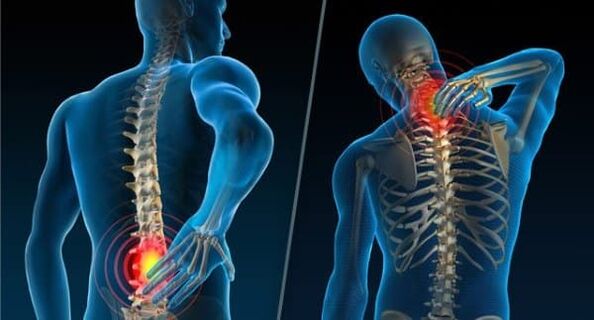
Weakening of the intervertebral discs or other spinal disorders that complicate or limit movement indicate the development of a serious disease - osteochondrosis. It can occur in anyone and is not associated with age. The spine is a load-bearing element of the skeleton, therefore its changes affect the quality of life and the state of many organ systems. Because of this, it is necessary to know the causes, signs of osteochondrosis, as well as treatment methods in order to detect disorders in time and prevent the development of pathology.
What is osteochondrosis?
Osteochondrosis is a complex of degenerative disorders in the human spine, manifested in dystrophic changes in the cartilage of this system.The disease can occur in any joint, but it develops much more often in the intervertebral discs.
The main sign indicating the development of the disease is pain in the back, neck and lumbar area. In the future, you may feel pain in your shoulders, arms, and upper thighs. In the absence of treatment, atrophy of muscle tissue begins, impaired sensitivity and activity of internal organs, which leads to an incurable condition.
ICD-10 code
The World Health Organization has developed the ICD-10 (International Classification of Diseases, tenth revision). Its essence is as follows: each disease has its own specific code, which consists of numbers and letters. The doctor, seeing that code in front of him, knows exactly what disease we are talking about and what treatment should be prescribed to save the patient from this problem.
According to ICD-10, osteochondrosis has the code M42 and belongs to the class "Diseases of the musculoskeletal system and connective tissue" (group "Dorsopathies", subgroup "Deforming dorsopathies").
Causes of development and risk factors.
There are many reasons for the appearance of osteochondrosis. They all depend on which part of the spine the disease develops: cervical, thoracic or lumbar. There are several main reasons for the development of the disease:
- hereditary predisposition. Congenital anomalies contribute to the development of diseases of the musculoskeletal system;
- Hormonal imbalance. Disruption of the endocrine system, overweight or underweight negatively affect the musculoskeletal system;
- Age-related changes in the body.. As a result, muscle, bone and cartilage tissue is destroyed, intervertebral discs wear out with age;
- Injuries and bruises of the spine. . Many people spend a lot of time in one position, for example sitting at a table, while others do the same type of physical work. All of this causes damage to the bone and ligamentous apparatus of the spine, as well as injuries to the intervertebral discs;
- Degenerative changes in muscle tissue.. These processes appear due to overstrain of individual muscle groups, which most often leads to thoracic osteochondrosis.
- Sedentary lifestyle. Muscle atrophy occurs, which causes circulatory disorders and inadequate formation of the bone skeleton.
Most people do not pay attention to their diet and eat foods that are not healthy at all. Because of this, a nutritional deficiency occurs, which negatively affects the integrity of the intervertebral cartilage, its mobility and elasticity.
There are several risk factors for developing this disease:
- hypothermia;
- flatfoot;
- complications after infectious diseases;
- over weight;
- sedentary lifestyle;
- spinal injuries.
When the intervertebral discs and cartilage tissue are damaged, it is important to determine the cause of the disease and begin appropriate treatment.
Types and symptoms
Depending on the location of the pathological process, several types of osteochondrosis are distinguished.
Osteochondrosis of the cervical spine.
It manifests itself as pain in the neck, neck and between the shoulder blades. During sleep, neck mobility may be limited. Often with cervical osteochondrosis, numbness of the fingers occurs. Dizziness and tinnitus are also noted. Types of cervical osteochondrosis differ in clinical manifestations:
- cervicalgia– accompanied by neck pain and limited mobility; the pain may extend to the shoulder region and the space between the shoulder blades; Tingling and burning sensations can often be observed in the hands and fingers;
- cervicocranialgia– accompanied by pain from the neck to the parietal and occipital parts of the head, shoulder girdle; muscle tension is characteristic, a feeling of petrification is created; headaches, nausea, tinnitus, imbalance are observed;
- cervicobrachialgia– characterized by stabbing, aching, pulling, stabbing pains; turning and tilting the head can cause an attack of acute pain and physical tension in the affected area, pain occurs in the arms and fingers, causing weakness in the upper extremities;
- discogenic root lesion– characterized by paroxysmal pain in the shoulder, forearms and fingers, which is accompanied by numbness and a feeling of cold; symptoms intensify when coughing, sneezing or suddenly turning your head; It can worsen at night and cause insomnia.
Osteochondrosis of the thoracic spine.
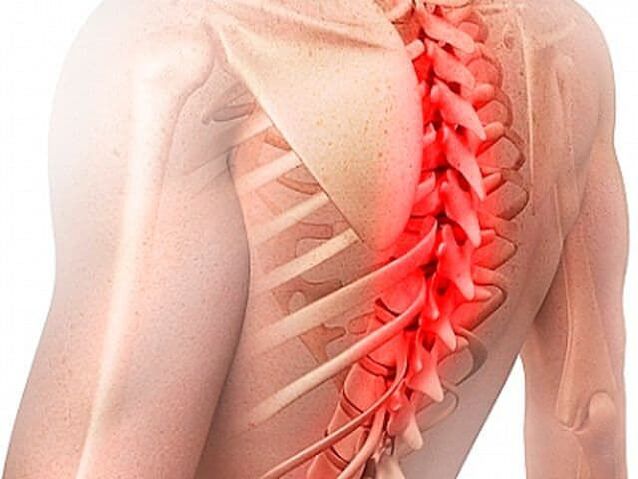
This is a rather rare form. In terms of its symptoms, thoracic osteochondrosis is similar to other diseases and therefore requires a differential diagnosis.As a result of the immobility of the thoracic vertebrae in this area, severe pain is not observed when moving.The pain syndrome extends to the sternum and under the shoulder blade. Thoracic osteochondrosis can lead to impaired functioning of internal organs. The main clinical manifestations of thoracic osteochondrosis are:
- Thoracalgia or intercostal neuralgia– this is irritation or compression of the intercostal nerves by muscles and tissues, which is accompanied by pain in the chest when bending, bending and twisting the body, under the ribs, in the front part of the chest, pain when inhaling, exhaling ; the pain may radiate to the shoulder and between the shoulder blades;
- pain syndrome, in which the pain is stabbing in nature; pain may be felt inside the chest, abdomen; worse with movement, coughing, sneezing, laughing; Sensitivity disorders are observed.
Thoracalgia (chest pain) is one of the most serious symptoms a person can experience. Sometimes even a doctor cannot immediately determine the cause of chest pain and determine whether this symptom is a sign of threat to the patient's life.
Osteochondrosis of the lumbosacral region.
The main reason for such changes is a lack of nutrients and excessive stress. The metabolism slows down, so the discs do not have time to renew themselves, their structure and properties are altered. There are several types of lumbar osteochondrosis:
- lumbago (acute lumbar lumbago)– acute pain in the lumbar spine that occurs when lifting weights, performing physical activity or bending; characterized by sharp pain on the right or left in the lumbar region; They also distinguish lumbago from sciatica, when the pain extends to the buttocks and legs;
- radicular vascular syndrome (radiculoischemia)It occurs when the radiculomedullary artery is damaged and is accompanied by paralysis of the extensors and flexors of the gluteal muscle group, the foot hangs weakly, there is no movement.
Osteochondrosis of the spine with radicular-vascular syndrome is a very dangerous pathology, which is expressed in acute pain, since CSS is usually a consequence of some disease.
Stages of development
The stages of osteochondrosis are characterized as follows:
- The initial stage begins with the loss of fluid reserves in the nucleus pulposus of the intervertebral discs. As a resultthe physiological position of the disc and the structure of the nucleus pulposus are altered.
- Further development of the disease (first degree) is due to a decrease in the height of the disc.Muscles and ligaments become overloaded and lose their ability to function normally.At this stage a vertebral displacement may appear.
- The second degree is characterized by changes in bone tissue.Osteoarthritis forms, subluxations occur..
- The third degree is determined by the fact thatBony growths (osteophytes) form on the spine.that cause damage to the nerve roots.
The development of osteochondrosis should not be neglected, since with each subsequent stage the course of treatment and rehabilitation increases. Complications that develop during an illness can have undesirable consequences.
What is the difference between radiculitis and osteoarthritis?
The symptoms of osteochondrosis and radiculitis are very similar, but the main difference between them is that in the first case they occur only in the later stages, while radiculitis is characterized by the early manifestation of severe symptoms.Additionally, with radiculitis, pressure on the paravertebral muscles and even tilting the head cause severe pain., similar to an electric shock, which does not occur with osteochondrosis.
Comparing osteochondrosis and osteoarthritis, it is worth noting that in the second disease all elements of the joint are affected, which causes creaking and limited mobility. Osteochondrosis, in turn, is characterized by the destruction of intervertebral discs with the formation of hernial protuberances.
Differential diagnostic methods are used to determine the disease. This is a comprehensive approach that requires effort and time.
Diagnosis
If there is a suspicion of osteochondrosis, the doctor prescribes a comprehensive diagnosis, which consists of the following studies.
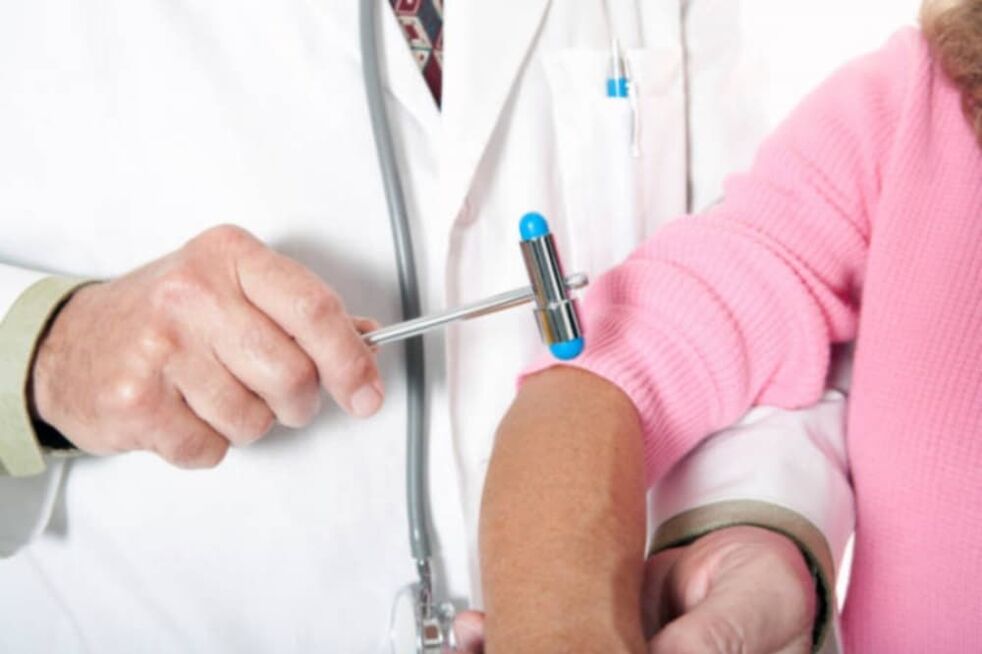
Neurological examination
It is performed by a neurologist. This exam includes checking reflexes, muscle strength, and the extent of pain in other parts of the body.Neurological examination is very important for osteochondrosis., because this disease affects the functioning of the nerve endings and the spinal cord.
Spinal myelography
It allows you to see how cerebrospinal fluid spreads within the spinal membranes. This helps to identify pathologies of the spine, diseases of the nerve roots and spinal cord. Under local anesthesia, a special dye is injected into the spinal cord and nerve area. An X-ray machine provides a complete picture of the spine, especially the bones. This method allows you to identify any deviations.
Computed Tomography (CT)
These are images of one or two segments of the spine. With this procedure, you can see an image of the bone tissue of a certain region of the spine. The doctor interprets the resulting image and if a narrowing of the space between the vertebrae is seen, this indicates that the patient has osteochondrosis.
Nuclear magnetic resonance (MRI)
MRI uses strong magnetic fields and radio waves to create images of the human body from individual scans. With this method, ligaments, tendons and bone structures are very well differentiated.
Magnetic resonance imaging (MRI)
It is an effective procedure because it has a safe effect on the body: during the procedure, the results are achieved by using a magnetic field instead of radiation.
The prescribed treatment cannot be accepted without a preliminary comprehensive diagnosis. This can only lead to worsening health.
Treatment methods
Treatment of osteochondrosis involves many complex measures.Depending on the severity of the disease, a specific treatment strategy is selected.
drug therapy
As a rule, the treatment of osteochondrosis begins with taking a certain group of drugs:
- analgesics and various analgesics;
- medications that relieve spasms;
- vitamins B and C;
- medications that relieve inflammation;
- Medications that promote better blood circulation.
In addition to taking medications orally, patients are prescribed various non-steroidal ointments and gels that can relieve pain and reduce swelling in problem areas.
Physiotherapy
In addition to drug therapy, various physiotherapeutic procedures are used. Thanks to this method, medications can be administered directly to the site of inflammation. Main types of physiotherapy:
- Electrophoresis– performing physiotherapy with electric fields modulated by currents. This allows the drugs to enter the body. Helps relieve pain and muscle spasms;
- Magnetotherapy. This painless physiotherapy involves the positive effect of a magnetic field on the active cells of nerve and muscle fibers. As a result, the work of molecular structures is activated and the functional properties of blood vessels are improved;
- Ultrasound therapy. Ultrasound is sound waves produced in a range that the human ear cannot perceive. Thanks to this, blood circulation improves in the affected areas, spasms are relieved, pain is eliminated and inflammatory processes stop;
- vibration effect. With the help of mechanical vibrations, the affected area is affected;
- Balneotherapy. The essence of the method is the use of mineral water, which relaxes the muscles and has a beneficial effect on the musculoskeletal system. Use mineral water in the shower or bath.
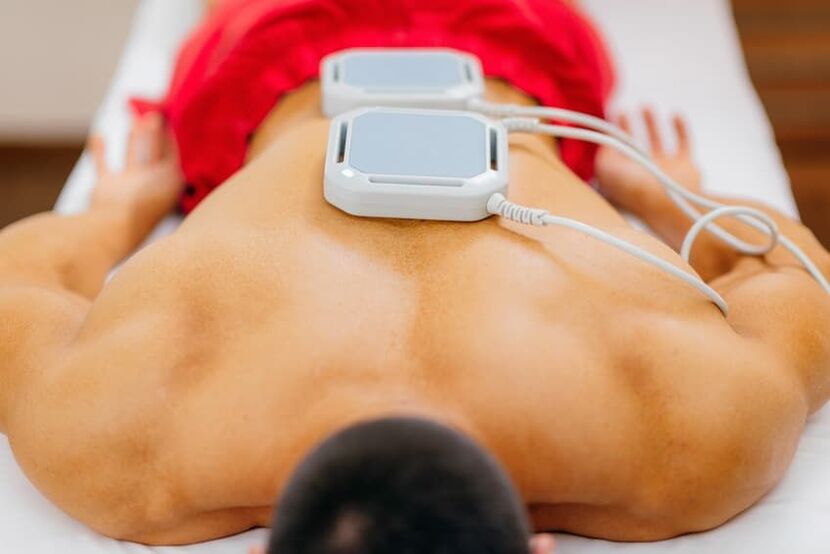
Physiotherapy should be carried out during the period of weakening of symptoms, when there is no pain. In the acute stage of the disease, the doctor selects a set of procedures that can eliminate pain syndrome. As a result of adequate physical treatment, the patient stops feeling pain, the spine becomes more mobile, which indicates recovery.
Traditional methods
Treatment of osteochondrosis may include the use of folk recipes, the effectiveness of which depends on the individual characteristics of the body. Here are some of them:
- You will need 300 g of radish juice, 200 g of honey and 100 g of vodka. Mix all the ingredients and lubricate the affected areas 2 times a day.
- You will need 1 tbsp. l. rye flour, 100 g butter, 1 tbsp. l. vinegar and 1 egg. Mix all the ingredients and leave for two days. Rub into affected areas.
- Grate the raw potatoes and mix with a little honey. Apply the prepared pulp to the sore spot for 2 hours.
Traditional treatment methods cannot act as independent therapy.To achieve a visible and long-lasting result, medicinal, conservative and folk methods must be combined.
Traction
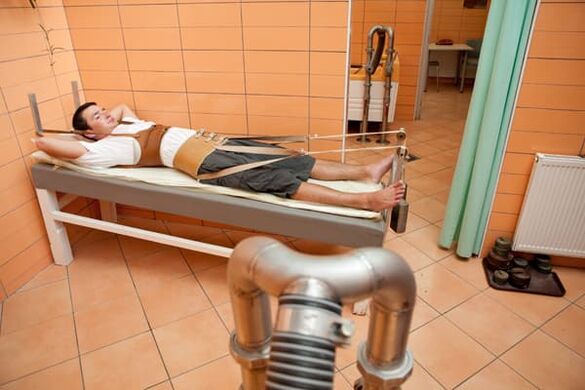
Spinal traction is often used for osteochondrosis. With the help of traction, muscle spasms are relieved, displacement of the vertebrae and deformation of the spine are eliminated. The procedure is carried out in a hospital. There are dry and underwater methods of spinal traction.
Dry traction is performed under the influence of the patient's weight, which is located on an inclined plane.To increase the pulling force, the doctor may use additional weights. With underwater traction, the healing effect is enhanced due to the effect of warm water on the body.
Under the influence of water, the distance between the vertebrae increases, vascular spasms in the affected area are eliminated, and blood supply improves.
Surgery
Surgical treatment of osteochondrosis is carried out in cases where there are serious complications.Such complications include: intervertebral disc herniation, vertebral displacement and a significant decrease in the lumen of the spinal canal.
In this case, several types of operations are performed. These include operations to secure displaced vertebrae with metal plates, insert artificial intervertebral joint implants, or remove individual bone growths.
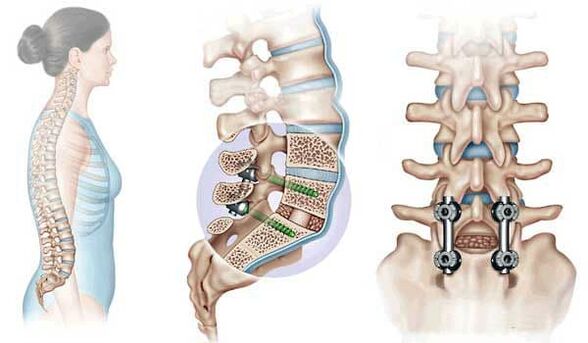
Physiotherapy
Physiotherapy for osteochondrosis is one of the most important aspects of treatment. As a result, blood circulation is gradually restored, the vertebrae return to their normal position, and the spine is significantly strengthened.
In the initial stages of the disease it consists of gymnastics.In cases where gymnastics does not bring positive results, the doctor selects an individual set of exercises for the patient., combined with other physiotherapy procedures.
Complications
The disease can cause the following complications:
- inflammatory diseases of the nerve roots (radiculitis, radiculopathy);
- intervertebral hernia;
- vegetative-vascular dystonia;
- various neurological complications;
- severe headaches, migraines;
- limb atrophy;
- spinal canal stenosis;
- spondyloarthrosis (proliferation of the edges of the articular surface as a result of deforming osteoarthritis);
- spinal cord stroke.
If drug therapy does not bring positive results, surgical treatment is prescribed. The slightest delay and failure to start treatment on time can lead to disability, since the spine will lose its properties and mobility.
If treatment is not started in a timely manner, complications such as malfunctioning of the organs of the reproductive and urinary system may occur.
Prevention
Treating osteochondrosis is quite difficult. Therefore, everything must be done to prevent the disease from arising in the body. To prevent the appearance of osteochondrosis, it is necessary to constantly carry out preventive measures:
- Goodorganize a workplace;
- when you work you needtake short breaksdo light gymnastics;
- watch your posture;
- dailythe walk should be easy, without constriction;
- Choose the right and comfortable pillow, elastic mattress.The sleeping surface should be flat.and elastic;
- The daily diet should contain a minimum of sweet and savory dishes, and more foods enriched with calcium. Vitamins C, E, B must be present. They will strengthen the cartilage tissue and make it elastic.
- Active lifestyle.
- prophylacticmassage.
- medicinalgym.
Preventive measures are also the main requirements during the rehabilitation period. Following these simple rules will allow you to avoid a relapse of the disease even after complete recovery.
conclusions
- Osteochondrosis is a degenerative disorder of the human spine.. Symptoms depend on the type of disease and the place of appearance (cervical, thoracic, lumbosacral).
- Complications of the disease can not only disrupt the integrity of the spine, but also significantly affect the functioning of other organ systems.
- Osteochondrosis can only be cured comprehensively, combining medication, physiotherapy and therapeutic exercises.
- Not complicatedPreventive measures will help protect your body from serious pathologies..



















